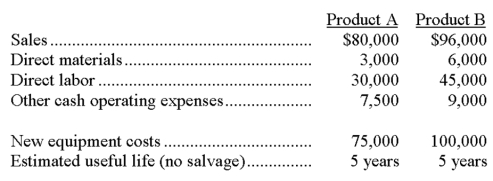Asked by autumn hager on Jul 04, 2024

Verified
A company is trying to decide which of two new product lines to introduce in the coming year. The predicted revenue and cost data for each product line follows:
The company has a 30% tax rate, it uses the straight-line depreciation method, and it predicts that cash flows will be spread evenly throughout each year. Calculate each product's payback period. If the company requires a payback period of three years or less, which, if either, product should be chosen?

Straight-Line Depreciation
A method of calculating the depreciation of an asset which assumes the asset will lose an equal amount of value each year over its useful life.
Tax Rate
The percentage at which an individual or corporation is taxed by the government on their income or profits.
- Analyze and compare different investment options based on their payback periods, accounting for tax, depreciation, and cash flows.

Verified Answer
HM
Hunter MiggelbrinkJul 10, 2024
Final Answer :
*Annual depreciation:
A = $75,000/5 yrs. = $15,000
B = $100,000/5 yrs. = $20,000
Payback periods:
(A) ($75,000/$32,150) = 2.3 years
(B) ($100,000/$31,200) = 3.2 years
Based on the payback period, Product A should be chosen.

A = $75,000/5 yrs. = $15,000
B = $100,000/5 yrs. = $20,000
Payback periods:
(A) ($75,000/$32,150) = 2.3 years
(B) ($100,000/$31,200) = 3.2 years
Based on the payback period, Product A should be chosen.


Learning Objectives
- Analyze and compare different investment options based on their payback periods, accounting for tax, depreciation, and cash flows.